VI.9.6 Pompeii. Casa dei
Dioscuri or House of Castor & Pollux
or House of M. Nigidius Vaccula or N. Nasennius Nigidius Vaccula, or Casa de’ due fratelli.
Rear entrance at VI.9.9.
Excavated 1826, 1828, 1837. (Strada
di Mercurio 11).
Linked to VI.9.7 and VI.9.8.
Atrium
Large
peristyle Pseudoperistyle and east side

VI.9.6 Pompeii.
November 2023.
Looking north along
east side of Via di Mercurio, from entrance doorway. Photo courtesy of Giuseppe
Ciaramella.
![VI.9.6 Pompeii. September 2005. Looking north past entrance on Via di Mercurio from outside VI.9.7. Fiorelli thought that one patron owned all of the remaining big house of the insula (VI.9.6/7), and he had it decorated externally with a red painted podium but this was covered and degraded by much graffiti and writings, one of the most notable recording the fight between the Nucerians and Pompeians
Campani Victoria una
cum Nucerinus peristis
See Pappalardo, U., 2001. La Descrizione di Pompei per Giuseppe Fiorelli (1875). Napoli: Massa Editore. (p.65)
According to Cooley, this translates as “Campanians, in our victory you perished with the Nucerians”. [CIL IV 1293, ILS 6443a]
See Cooley, A. and M.G.L., 2004. Pompeii : A Sourcebook. London : Routledge. (p.62)
According to Pagano and Prisciandaro, found in September or October 1828, written with an iron point in small letters, was the inscription –
Campani Victoria una
cum Nucerinus peristis [CIL IV 1293]
See Pagano, M. and Prisciandaro, R., 2006. Studio sulle provenienze degli oggetti rinvenuti negli scavi borbonici del regno di Napoli. Naples : Nicola Longobardi. (p.139) and PAH II, 215-6.
According to Breton, on the facade one could read many inscriptions but by then (1870) many were faded and unreadable, but many had also been published.
See Breton, Ernest, 1870. Pompeia, Guide de visite a Pompei, 3rd ed. Paris, Guerin.
See Epigraphik-Datenbank Clauss/Slaby (See www.manfredclauss.de)](6%2009%2006%20atrium%20part%201_files/image004.jpg)
VI.9.6 Pompeii. September 2005. Looking north past entrance on Via di Mercurio from outside VI.9.7.
Fiorelli thought that one patron owned all of the remaining big house of the insula (VI.9.6/7), and that he had it decorated externally with a red painted podium but this was covered and degraded by much graffiti and writings, one of the most notable recording the fight between the Nucerians and Pompeians
Campani Victoria
una
cum Nucerinus
peristis
See Pappalardo, U., 2001. La Descrizione di Pompei per Giuseppe Fiorelli (1875). Napoli: Massa Editore. (p.65)
According to Cooley, this translates as “Campanians, in our victory you perished with the Nucerians”. [CIL IV 1293, ILS 6443a]
See Cooley, A. and M.G.L., 2004. Pompeii: A Sourcebook. London: Routledge. (p.62)
According to Pagano and Prisciandaro, found in September or October 1828, written with an iron point in small letters, was the inscription –
Campani Victoria
una
cum Nucerinus
peristis [CIL IV 1293]
See Pagano, M. and Prisciandaro, R., 2006. Studio sulle provenienze degli oggetti rinvenuti negli scavi borbonici del regno di Napoli. Naples: Nicola Longobardi. (p.139) and PAH II, 215-6.
According to Breton, on the facade one could read many inscriptions but by then (1870) many were faded and unreadable, but many had also been published.
See Breton, Ernest, 1870. Pompeia, Guide de visite a Pompei, 3rd ed. Paris, Guerin.
See Epigraphik-Datenbank Clauss/Slaby (See www.manfredclauss.de)

VI.9.6
Pompeii. November 2023.
Looking south along
east side of Via di Mercurio, from entrance doorway. Photo courtesy of Giuseppe
Ciaramella.

VI.9.6 Pompeii. July 2017. Looking north-east towards entrance
doorway on Via di Mercurio.
Foto Annette Haug, ERC Grant 681269 DÉCOR.

VI.9.6 Pompeii. May 2012. Looking east towards entrance doorway on Via di Mercurio. Photo courtesy of Buzz Ferebee.

VI.9.6 Pompeii. May 2012. Wall between VI.9.6 and VI.9.7 on Via di Mercurio. Photo courtesy of Buzz Ferebee.
![VI.9.6 Pompeii. September 2005. Wall between VI.9.6 and VI.9.7 on Via di Mercurio.
Many writings were found on these walls, for example on 30th September 1828 -
A(ulum) Vettium Firmum
aed(ilem) v(irum) b(onum) o(ro) v(os) f(aciatis) Felix cupit [CIL IV 174]](6%2009%2006%20atrium%20part%201_files/image012.jpg)
VI.9.6
Pompeii. September 2005. Wall between VI.9.6 and VI.9.7 on Via di Mercurio.
Many writings were found on these walls, for example on 30th September 1828 -
A(ulum) Vettium
Firmum
aed(ilem) v(irum)
b(onum) o(ro) v(os) f(aciatis) Felix
cupit [CIL IV 174]
![VI.9.6 Pompeii. 1830. Wall between VI.9.6 and VI.9.7 on Via di Mercurio. Drawing of graffiti CIL IV 175.
See Real Museo Borbonico Vol 6. 1830.
A(ulum) Vettium Firmum aed(ilem) o(ro) v(os) f(aciatis)
Fuscus cum Vaccula facit [CIL IV 175]
See Pagano, M. and Prisciandaro, R., 2006. Studio sulle provenienze degli oggetti rinvenuti negli scavi borbonici del regno di Napoli. Naples: Nicola Longobardi. (p.139-40) and PAH II, 216: III,91.](6%2009%2006%20atrium%20part%201_files/image013.jpg)
See Real Museo Borbonico Vol 6. 1830.
A(ulum) Vettium
Firmum aed(ilem) o(ro)
v(os) f(aciatis)
Fuscus cum
Vaccula facit [CIL IV 175]
See Pagano, M. and Prisciandaro, R., 2006. Studio sulle provenienze degli oggetti rinvenuti negli scavi borbonici del regno di Napoli. Naples: Nicola Longobardi. (p.139-40) and PAH II, 216: III,91.
According to Della Corte, he thought Fuscus was a neighbour of the Vaccula family.
On the outside wall was another recommendation of this same Fuscus for the same candidate -
A(ulum) Vettium
Firmum
aed(ilem) v(iis)
a(edibus) s(sacris) p(ublicis)
p(rocurandis) o(ro) v(os)
f(aciatis) Fuscus (rogat) [CIL IV 176].
Higher up on the same wall outside VI.9.6, was another electoral recommendation, which according to Della Corte was the joint recommendation of the two neighbours - Fuscus cum Vaccula facit [CIL IV 175, see above].
Della Corte knew of two Pompeians with the cognomen M.
Nigidius Vaccula and N. Nasennius Nigidius Vaccula.
The first was noted for donating the mobile bronze brazier, signed with his
name (brazier, palette (fire shovel) and seats) to the public baths, known by
the name Forum Baths, and the other Stabian Baths.
The second name was recorded in the apocha Iuc. VI, which referred to the accounts of the heirs of the defunct N. Nasennius Nigidius Vaccula and payment made to a servant, Salvius, in the year 54, etc
See Della Corte,
M., 1965. Case ed Abitanti di Pompei. Napoli:
Fausto Fiorentino. (p.51).

VI.9.6 Pompeii. October 2022. Looking east to entrance doorway. Photo courtesy of Klaus Heese.

VI.9.6 Pompeii.
March 2009. Entrance doorway.

VI.9.6 Pompeii.
W.748. Entrance doorway. Photo by Tatiana Warscher.
Photo © Deutsches
Archäologisches Institut, Abteilung Rom, Arkiv.

VI.9.6 Pompeii. W.168. Entrance doorway, right hand pillar, 1830 drawing by Marsigli of painting of Fortuna and Mercury.
According to Fröhlich, the painting was on the right-hand pillar of entrance 6.
Fortuna, crowned and in Chiton and cloak, holds the cornucopia and a rudder which rests on a globe.
She looks right to Mercury, who is hurrying away to the right.
Mercury is wearing a white tunic, red cloak, petasos (winged helmet), and has winged feet.
He is carrying the Caduceus (staff) and Marsupium (purse).
In the background is a small house in a landscape.
See Fröhlich, T.,
1991. Lararien und Fassadenbilder in den
Vesuvstädten. Mainz: von Zabern. F39, p.321, abb. 9.
See Real Museo Borbonico Vol. VI, 1830, Tav. II.
Photo by Tatiana Warscher. Photo © Deutsches Archäologisches Institut, Abteilung Rom, Arkiv.

VI.9.6 Pompeii. c.1830. Drawing by Gell of Fortuna and Mercury.
See Gell, W. Sketchbook of Pompeii, c.1830.
See book from Van Der Poel Campanian Collection on Getty
website http://hdl.handle.net/10020/2002m16b425

VI.9.6 Pompeii. October
2023. Exterior front facade on north side of entrance doorway, on right. Photo
courtesy of Johannes Eber.

VI.9.6 Pompeii. July 2017. Front facade on north side of entrance
doorway.
Foto Annette Haug, ERC Grant 681269 DÉCOR.

VI.9.6 Pompeii. July 2017. Upper doorway above entrance doorway.
Foto Annette Haug, ERC Grant 681269 DÉCOR.

VI.9.6 Pompeii. July 2017. Detail
from upper doorway on south side of doorway.
Foto
Annette Haug, ERC Grant 681269 DÉCOR.

VI.9.6
Pompeii. October 2014. Detail from upper front façade on south side of doorway.
Foto
Annette Haug, ERC Grant 681269 DÉCOR.

VI.9.6 Pompeii. July 2017. Front facade on south side of entrance
doorway.
Foto Annette Haug, ERC Grant 681269 DÉCOR.

VI.9.6 Pompeii. W.755. Looking north on Via Mercurio, with remains of building debris on either side of doorway.
Photo by Tatiana
Warscher. Photo © Deutsches Archäologisches Institut, Abteilung Rom, Arkiv.

VI.9.6 Pompeii. W.761. Threshold or sill of entrance doorway.
Photo by Tatiana
Warscher. Photo © Deutsches Archäologisches Institut, Abteilung Rom, Arkiv.

VI.9.6 Pompeii. September 2017. Entrance doorway threshold.
Foto Annette Haug, ERC Grant 681269 DÉCOR.

VI.9.6 Pompeii. October 2022.
Looking east from entrance doorway, across atrium towards peristyle. Photo courtesy of Klaus Heese.

VI.9.6 Pompeii, August 2021. Looking east from entrance corridor,
across atrium to garden area. Photo courtesy of Robert Hanson.

VI.9.6 Pompeii, April 2019.
Looking east from entrance corridor, across atrium to garden. Photo
courtesy of Rick Bauer.

VI.9.7 Pompeii. September 2017. Looking east from entrance
corridor, across atrium to garden.
Foto Annette Haug, ERC Grant 681269 DÉCOR.

VI.9.6 Pompeii. September 2004. Looking east across atrium to garden.

VI.9.6 Pompeii. September 2017.
Looking towards north wall of entrance corridor/fauces leading
into atrium.
Foto Annette Haug, ERC Grant 681269 DÉCOR.

VI.9.6 Pompeii. December 2006. North wall of fauces, leading to atrium.

VI.9.6 Pompeii. November 2023.
Room 1, north wall
of entrance corridor/fauces with
copy of original painting, now in Naples Museum, inv. no. 9455.
Photo
courtesy of Giuseppe Ciaramella.

VI.9.6 Pompeii. Found 18th June 1828 in room 1, the fauces of entrance corridor.
Wall painting of one of the two Dioscuri.
Now in Naples Archaeological Museum. Inventory number 9455.

VI.9.6 Pompeii. March 2009. Room 1, north wall of fauces.

VI.9.6 Pompeii. W.765. Room 1, looking north-west towards north wall of fauces.
Photo by Tatiana
Warscher. Photo © Deutsches Archäologisches Institut, Abteilung Rom, Arkiv.

VI.9.6 Pompeii. W.766. Room 3, looking north across west portico towards rooms in north-west corner of atrium.
On the left is the north wall of the entrance corridor, room 1 with painted plaster.
Photo by Tatiana
Warscher. Photo © Deutsches Archäologisches Institut, Abteilung Rom, Arkiv.

VI.9.6 Pompeii. March 2009. Room 3, capital in atrium.

VI.9.6 Pompeii. March 2009. Room 3, capital in atrium.

VI.9.6 Pompeii. W.767.
Room 1, remains of painted decoration of plant with hovering bird from north wall of fauces or entrance corridor.
Photo by Tatiana
Warscher. Photo © Deutsches Archäologisches Institut, Abteilung Rom, Arkiv.

VI.9.6 Pompeii. September 2017.
South wall of entrance corridor/fauces, leading to atrium, with doorway to room 2.
Foto
Annette Haug, ERC Grant 681269 DÉCOR.

VI.9.6 Pompeii. December 2006. South wall of fauces, leading to atrium, with doorway to room 2.

VI.9.6 Pompeii. March 2009. Room 1, south wall of fauces.

VI.9.6 Pompeii. November
2023.
Room 1, south wall of entrance fauces/corridor with copy of
original painting, now in Naples Museum, inv. no. 9453.
Photo courtesy of Giuseppe Ciaramella.

VI.9.6 Pompeii. April 2019.
Room 1, south wall of entrance fauces/corridor with copy of
original painting, now in Naples Museum.
Photo courtesy of Rick Bauer.

VI.9.6 Pompeii. Found 18th June 1828 in room 1, fauces or entrance corridor.
Wall painting of one of the two Dioscuri.
Now in Naples Archaeological Museum. Inventory number 9453.
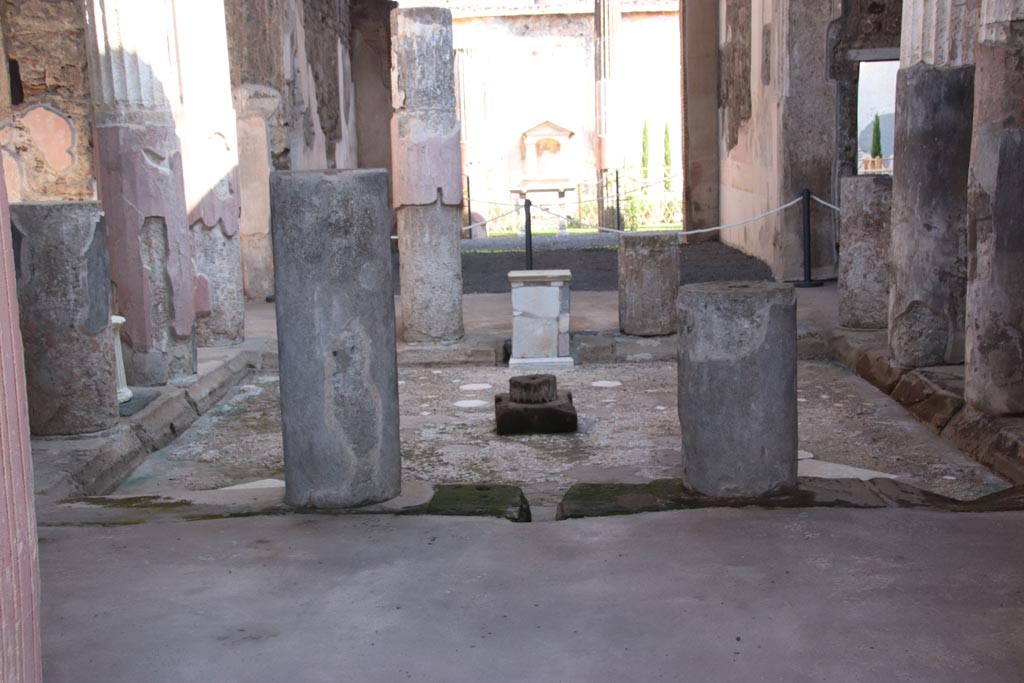

Room 3, looking east across impluvium towards tablinum and newly planted garden area. Photo courtesy of Johannes Eber.

VI.9.6 Pompeii. May 2006. Room 3, looking east across impluvium in atrium.

VI.9.6 Pompeii. November
2023.
Looking east towards
tablinum and garden area, across south side of impluvium in atrium. Photo
courtesy of Giuseppe Ciaramella.

VI.9.6 Pompeii. October 2022.
Room 3, looking south-east across impluvium in atrium from
entrance doorway.
Photo courtesy of Klaus Heese.
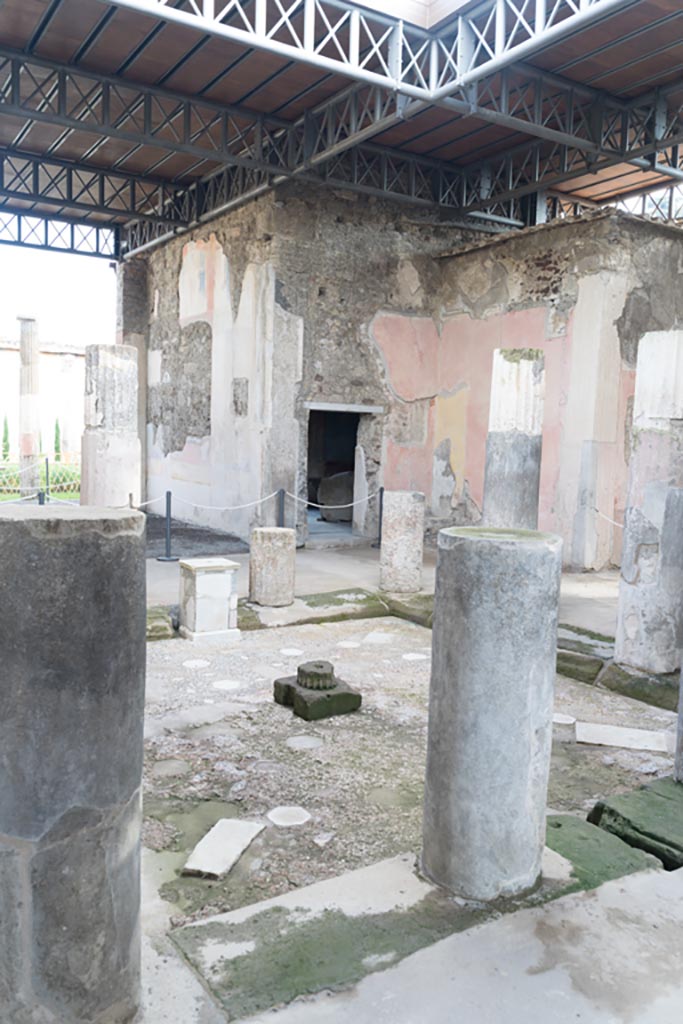
Room 3, looking south-east across impluvium in atrium. Photo courtesy of Johannes Eber.
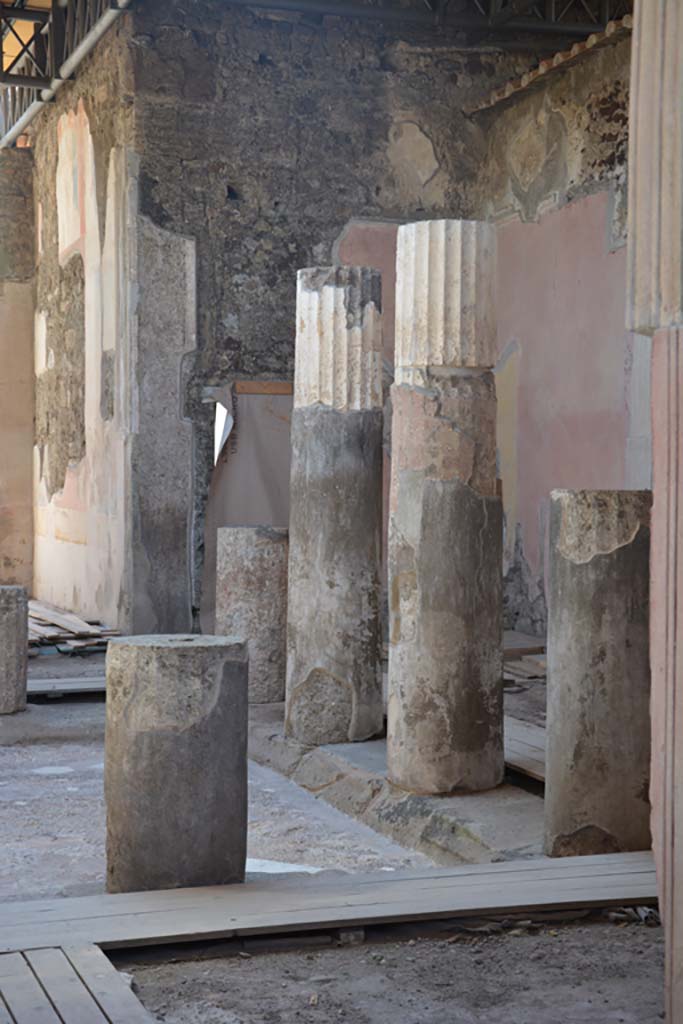
VI.9.6 Pompeii. July 2017. Room 3, looking south-east across
impluvium in atrium.
Foto Annette Haug, ERC Grant 681269 DÉCOR.

VI.9.6 Pompeii.
March 2009. Room 3, marble podium in atrium.
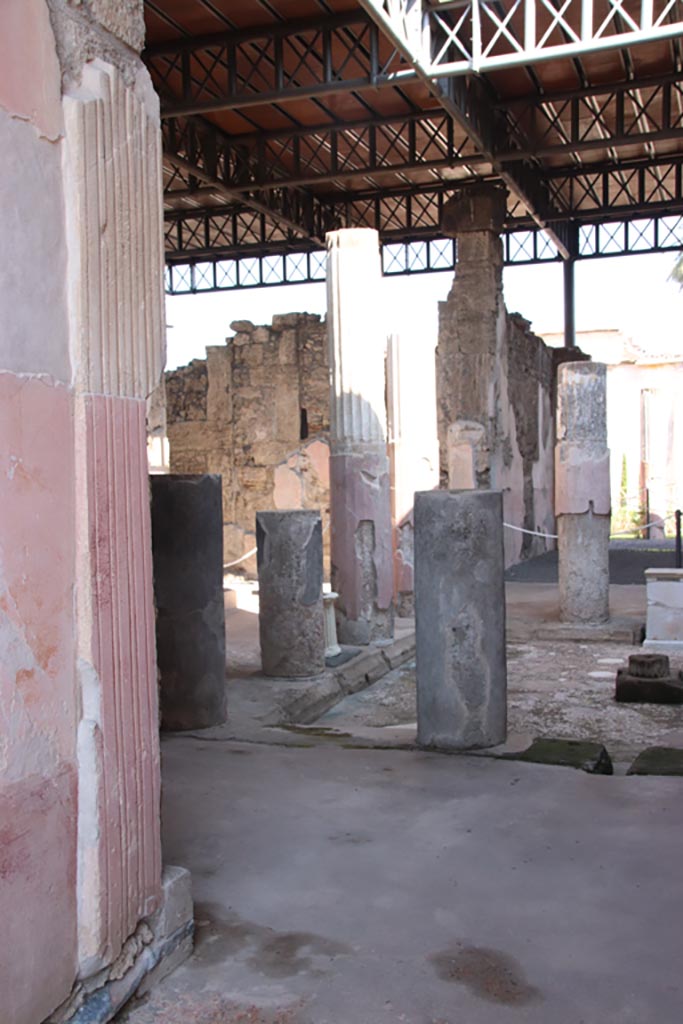
Room 3, looking north-east from entrance doorway across impluvium in atrium.
Photo courtesy of Klaus Heese.

VI.9.6 Pompeii. March 2009. Room 3, looking north-east across impluvium in atrium.
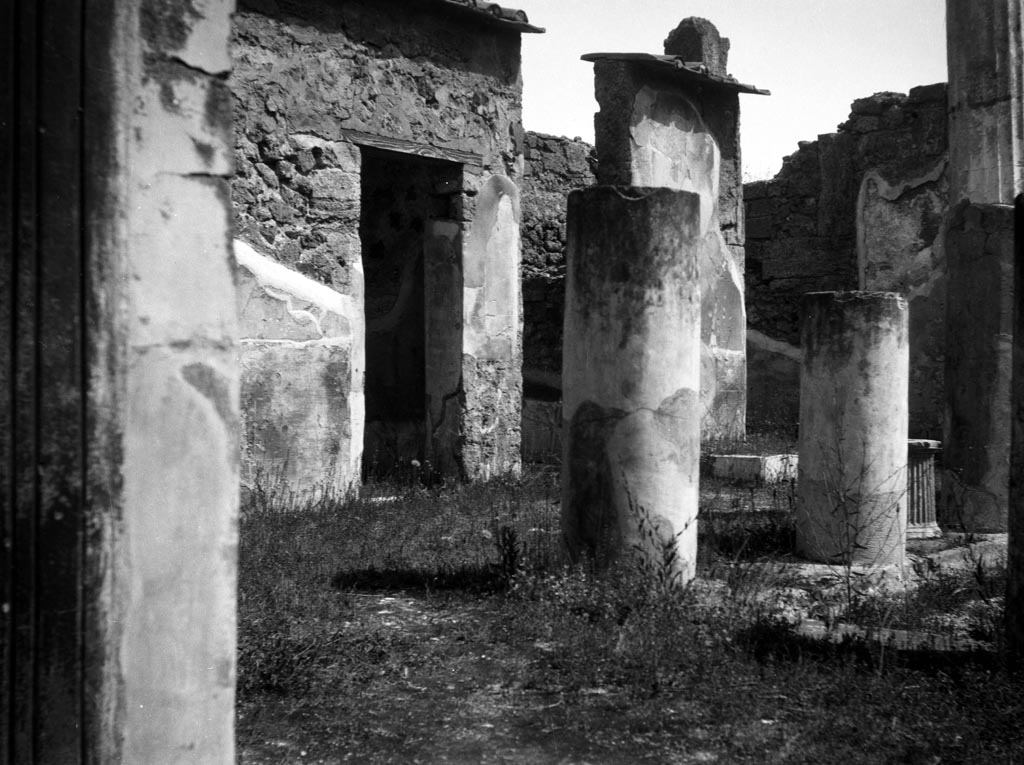
VI.9.6 Pompeii. W.808. Room 3, looking north-east along north side and corner of impluvium in atrium.
Photo by Tatiana
Warscher. Photo © Deutsches Archäologisches Institut, Abteilung Rom, Arkiv.
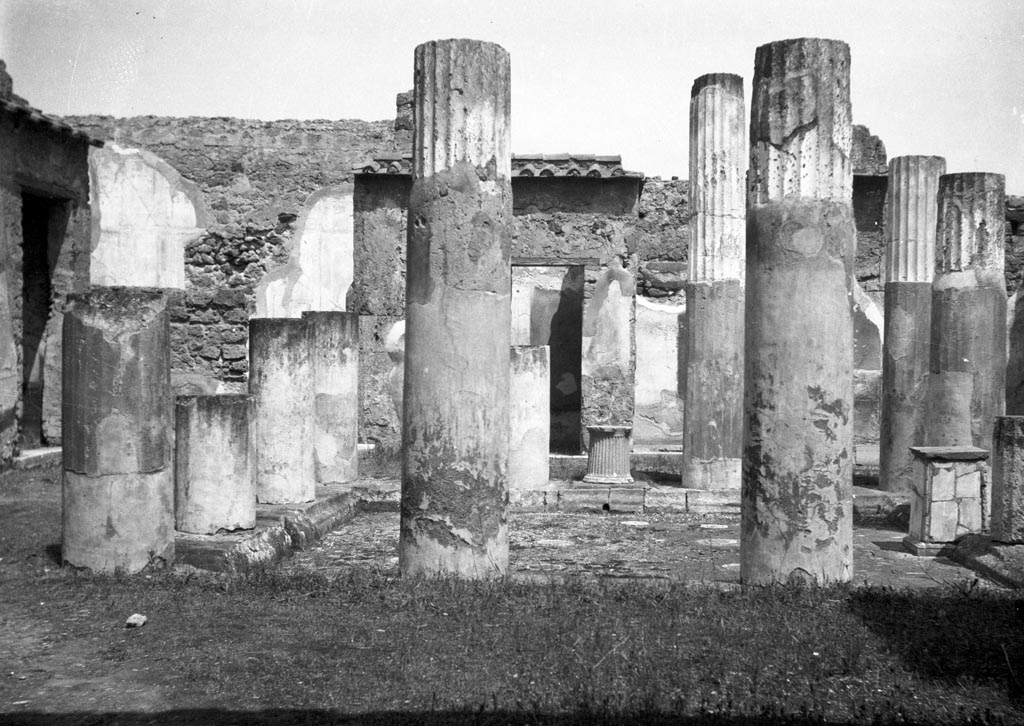
VI.9.6 Pompeii. W.768. Room 3, looking north across impluvium in atrium.
Photo by Tatiana
Warscher. Photo © Deutsches Archäologisches Institut, Abteilung Rom, Arkiv.
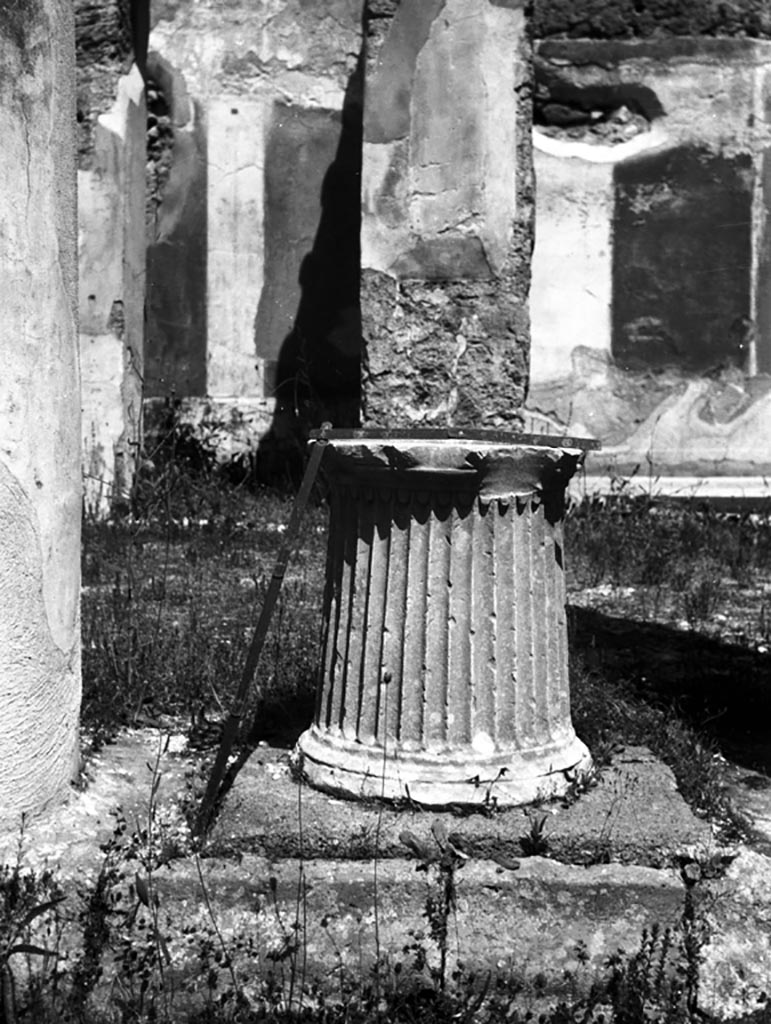
VI.9.6 Pompeii. W.784. Room 3, travertine puteal on north side of impluvium in atrium.
The painted walls of rooms 13 and 12 can be seen, in the background.
Photo by Tatiana
Warscher. Photo © Deutsches Archäologisches Institut, Abteilung Rom, Arkiv.
Atrium: 1 2 3 4 5 6 7 8 9 10 Plan
Large peristyle Pseudoperistyle and east side